By Bruce Newton, carsales.com.au
The Ford Mustang is so intrinsically defined by its heritage that it can only be one thing: a low-slung two-door muscle car. It’s an automotive icon that has been immortalised in popular culture, on the big screen and in motorsport all around the world. It is to the Blue Oval what the 911 is to Porsche, or the Range Rover is to Land Rover. The Mustang is what it is because that’s what has always been… until now.
The arrival of the Ford Mustang Mach-E is a controversial one, because a five-door, family SUV powered by electric motors wearing the famous pony badge is a big swing by Ford; one that could potentially alienate its most passionate owners or, as it hopes, drag them into the future while also appealing to a much wider audience.
It’s an interesting move that makes the Mach-E even more intriguing than if were to adopt the Escape nameplate from the now defunct mid-size SUV it effectively replaces.
We spent a week in the Mustang Mach-E Premium to figure out if it carries enough of the Mustang’s DNA to justify the badge, and how it stacks up in the toughest EV segment of all.
How much does the Ford Mustang Mach-E cost?
The 2024 Ford Mustang Mach-E is offered in three model grades, starting with the entry-level Mach-E Select at $72,990 (plus on-road costs) and topping out at $104,990 (plus ORCs) for the flagship GT, the only version with a dual-motor set-up.
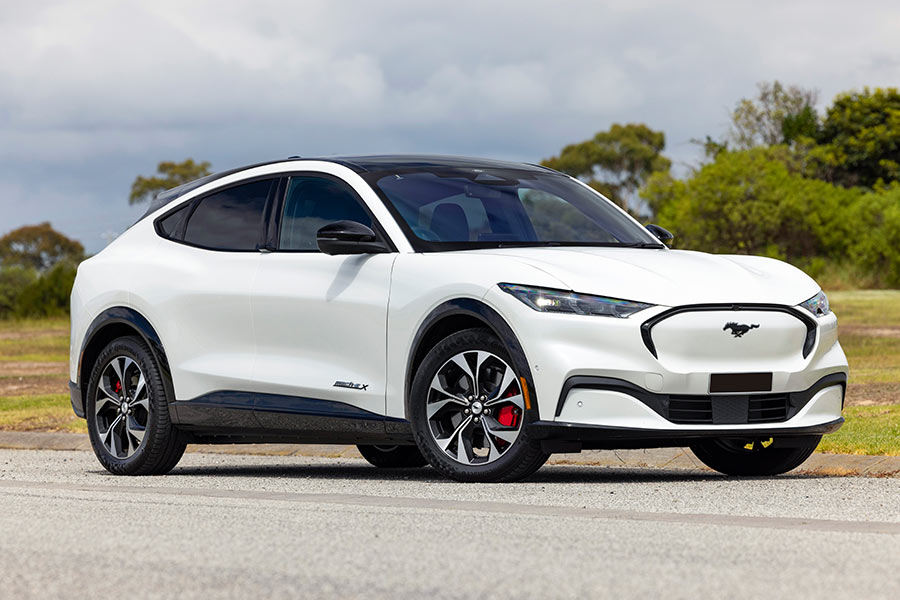
We’re testing the middle of the range Premium, which costs from $86,990 (plus ORCs).
The Mach-E’s only been on-sale since last October but has already had one price chop with the Premium model’s list price reduced by $4675 to lower it below the Fringe Benefits Tax limit when purchased via a novated lease.
Even adjusted, the Premium still looks rather expensive for a single-motor crossover compared to its rivals. The entry-level versions of the Tesla Model Y and Hyundai IONIQ 5 are both more than $20,000 cheaper while The Polestar 2 undercuts it by more than $18,000 and the Kia EV6 has a $10,000 head start.
What equipment comes with the Ford Mustang Mach-E?
From the outside, there’s little difference between the entry-level Select and mid-spec Premium models, except for the gloss black cladding and the lack of aero covers on the 19-inch alloy wheels.
Inside the cabin, it is quite well equipped with a panoramic glass sunroof, powered tailgate, keyless entry, dual-zone climate control, heated steering wheel, heated, eight-way power adjustable front seats and metal scuff plates and pedals. It also picks-up the multi-colour ambient interior lighting from the GT, as well as its red brake callipers.
Interestingly, all Mach-E models feature press buttons on the B-pillar rather than traditional handles to open the doors. It’s designed to improve aerodynamics but seems unnecessarily fussy. Speaking of fuss, no Mach-E has a spare tyre of any kind, so if you get a puncture, you’re in trouble.
All of the seven colours bar black cost an extra $700.
The Mustang Mach-E comes with a five-year/unlimited kilometre warranty, roadside assistance for up to seven years and a 12-month/15,000km service schedule. The first five visits average out at $156 each, while battery warranty is a maximum eight years and 160,000km.
What technology does the Ford Mustang Mach-E feature?
There’s nothing ‘old school’ about the Mustang’s interior, with a huge 15.5-inch infotainment screen in the middle of the dashboard that makes quite a statement. Supporting it is a thin, rectangular 10.2-inch digital instrument panel.
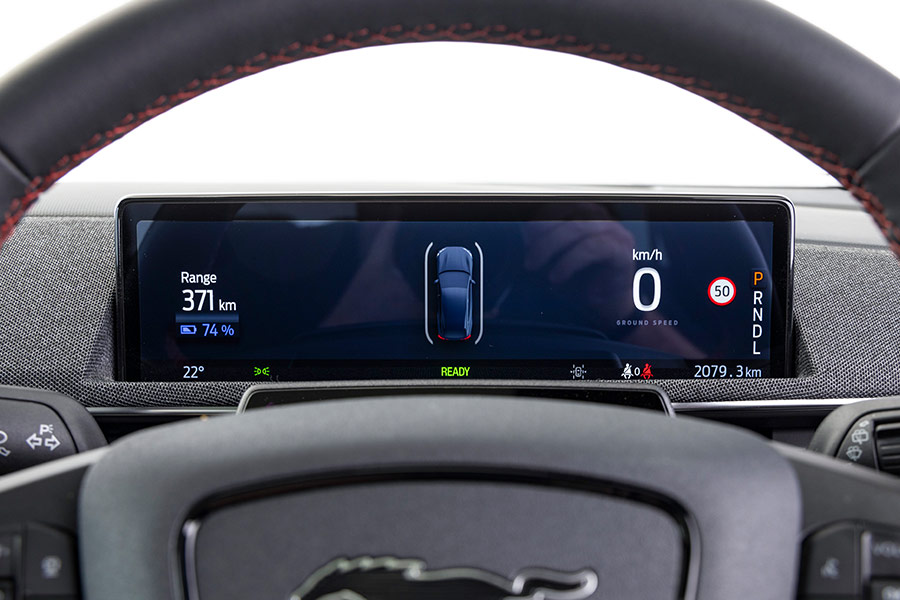
Key infotainment features – and they are standard for all Mach-Es – include wireless Apple CarPlay and Android Auto, Bluetooth phone/audio streaming, AM/FM and digital radio bands, embedded satellite-navigation, a 10-speaker B&O sound system and voice assistant. Smartphones can be wirelessly charged in the Mach-E.
The Mustang Mach-E also features an embedded modem to access the FordPass smartphone app that offers remote door lock/unlock, preconditioning cabin temp, checking the charge and even locating the vehicle remotely with a mapping feature.
What is the Ford Mustang Mach-E like inside?
Open the doors and the Mach-E is nothing like the Mustang Coupe. Where the traditional version carries retro hallmarks in its design and is really only built for two passengers (the back seats are only useful to carry an additional day bag or two and definitely not your family or friends), the Mach-E has space for five, although two fit better in the rear than three, with decent head room across both rows.
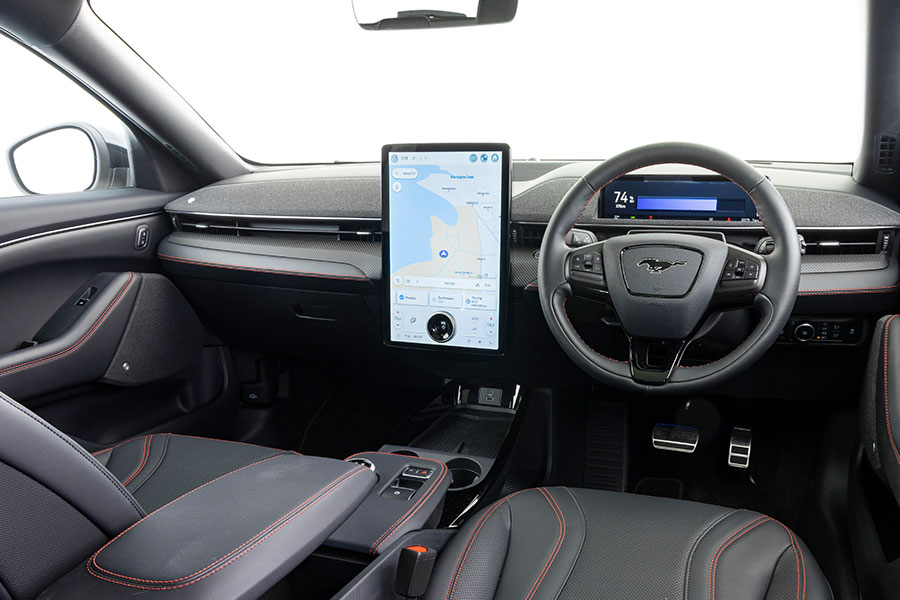
The seats are comfortable, and it is commendable that the driver’s seat height adjust works off both front and rear edges. The driver should be able to attain the correct position with a generous level of steering wheel reach and rake adjustment and a big left footrest on offer.
There are plenty of places to put phone, wallets, smart key and so on via bins, cupholders, storage slots and the glovebox. The lidded bin in the centre console includes both USB-A and USB-C points.
Rear seat passengers are also looked after with air vents and USB-A and USB-C ports.
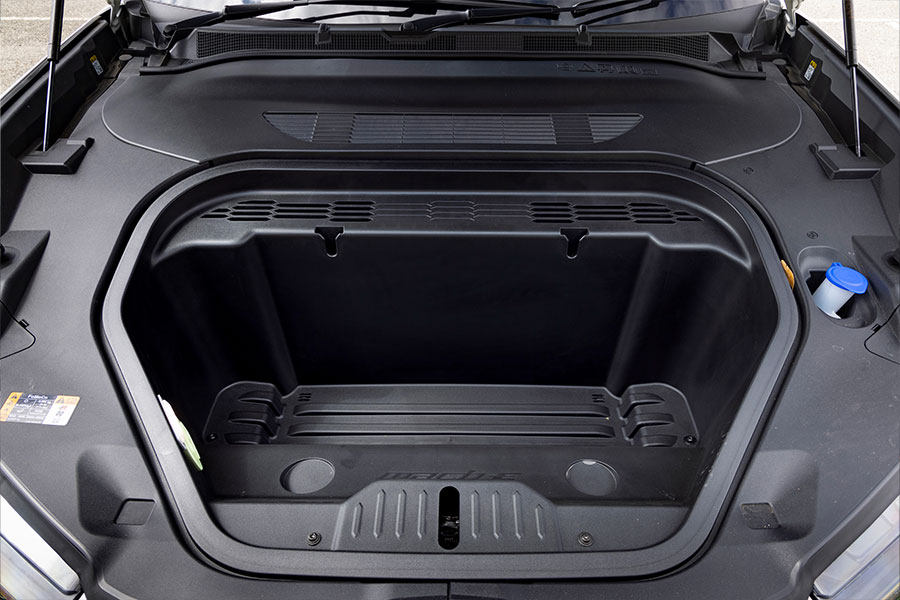
A 519-litre boot (measured to the roof) is adequate enough, though not in the same league as the Tesla for carrying luggage. There is, however, a generous 134 litres of additional storage under the bonnet in the front trunk, or frunk.
Flip down the split-folding rear seat and space grows to 1420 litres, which is great for carrying substantial loads like mountain bikes.
The quality of the trim materials in the Mexico-built Mach-E are of a high standard, varying between cloth, leather and some form of carbon-fibre looking plastics.
And that huge screen is a bonus for people like me who nowadays need sizable numbers and letters to read. It’s especially good for mapping.
So, what’s not to like? Well, we found the menu system in the touchscreen required deep drilling through the functions to change the vehicle settings. Having said that, the retention of a volume hard button and permanent air-con controls is sensible.
How safe is the Ford Mustang Mach-E?
The 2024 Ford Mustang Mach-E Premium scores the maximum five-star ANCAP rating based on superseded 2021 protocols. It features front, front-side, front-centre, rear-side, curtain, and driver’s knee airbags.
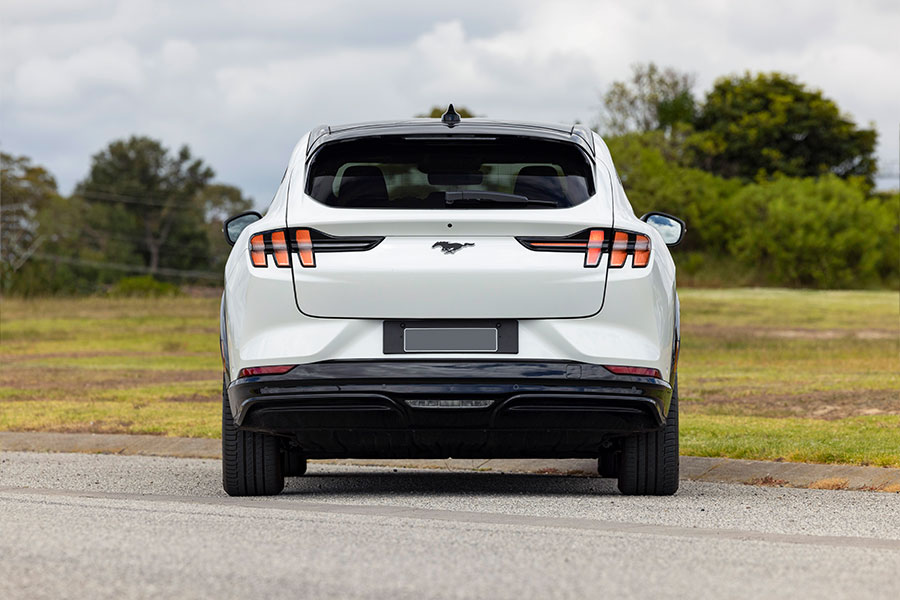
It is supplemented by a comprehensive suite of electronic driving assistance aids, including autonomous emergency braking that can detect pedestrians and cyclists as well as vehicles while also being able to see around intersections.
Other features include adaptive cruise control with stop-and-go and lane centring, lane keeping with departure warning, evasive steer assist, post impact braking, blind-spot monitoring with cross traffic alert/braking, reverse braking, speed sign recognition and driver monitoring.
The Mach-E proved itself a decent hands-free freeway cruiser, but it lacks the elite level of tuning the Ford Ranger system has. It lost its way that bit sooner when the road curved.
The Mach-E Premium comes with excellent LED projector headlights with auto high beam and glare reduction that shields oncoming drivers from being blinded. There is a 360-degree parking display, front and rear parking sensors, active parking assist and two ISOFIX and three child seat top tethers.
What powers the Ford Mustang Mach-E?
The 2024 Ford Mustang Mach-E Premium is powered by a single permanent magnet synchronous electric motor that drives the rear wheels via a single speed reduction gear.
The e-motor generates 216kW/430Nm, is fed by a 91kWh (usable) lithium nickel manganese cobalt (NMC) chemistry battery pack from Korea’s LG and is claimed to accelerate the Premium from 0-100km/h in 6.2 seconds.
Right here is where the much of the price difference between the Premium and cheaper Select can be accounted for, as the latter’s e-motor makes 198kW/430Nm.
It also has a smaller 72kWh battery with a different chemical makeup, a lithium-iron phosphate pack from CATL in China. As a result, it accelerates from rest to 100km/h in 6.6 seconds.
How far can the Ford Mustang Mach-E go on a charge?
The larger, more advanced NMC battery not only delivers more power but is key to the Premium’s significantly longer driving range.
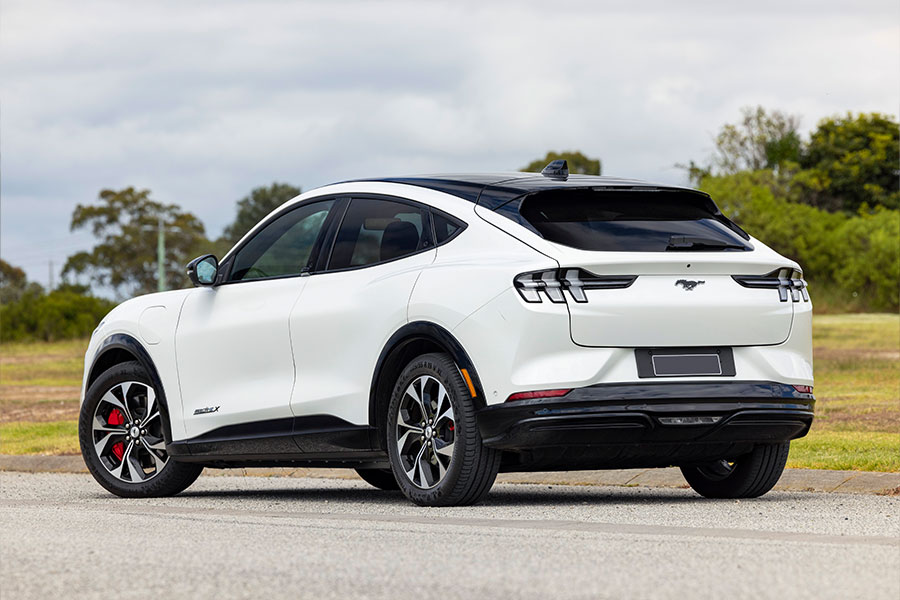
It can cover a claimed 600km on a single charge, compared to just 470km in the Select.
However, that claim proved consistently optimistic for us, if not egregiously so. At 80 per cent charge the predicted range was just under 400km. Over one 229km trip including suburbs, country road and freeway the range dropped 282km.
The Premium is also claimed to be more efficient at 17.3kWh/100km, compared to the Select’s 17.8kWh. This is another consequence of the different battery chemistries. However, LFP does have the advantage of being able to DC fast-charge to 100 per cent without issue whereas the NMC prefers to top-out at 80 per cent to prevent it from overheating.
The Mach-E can handle a maximum charging rate of 150kW on a DC fast charger, which is average at best these days. The fastest AC charging rate is 10.5kW, for which you will need to install a wallbox and have three-phase power.
During our test period we recorded average energy usage figures as low as 18kWh/100km and as high as 21kWh/100km. The Tesla Model Y generally averages in the low to mid-teens and the EV6 and IONIQ 5 also undercut the Mach-E in the real world.
Like its rivals, the Mach-E has the option of one-pedal driving to aid energy regeneration and it is effective. To activate this function requires a multi-tap process into the screen to turn it on and off, whereas it should be instantly accessible on the steering wheel or dash and preferably offer different levels of assistance.
What is the Ford Mustang Mach-E like to drive?
There are some basic numbers worth considering when it comes to the 2024 Ford Mustang Mach-E Premium that will give you a hint of its driving character.
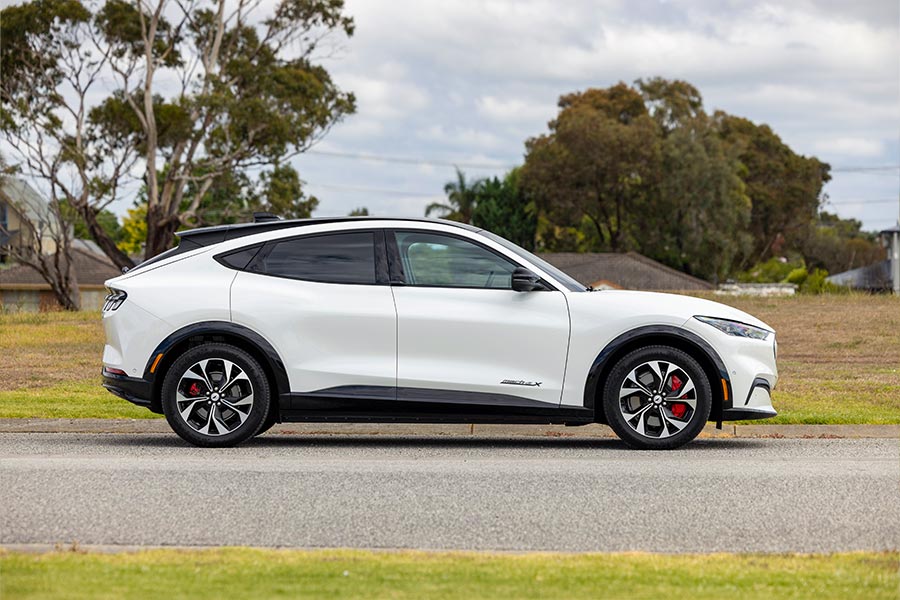
Firstly, it’s a reasonably big car that measures 4728mm long, is 1881mm wide, 1634mm high and has a long 2984mm wheelbase to accommodate its battery pack between the axles.
That battery pack also contributes to the Premium’s substantial 2098kg kerb weight. Mind you, it is slightly lighter than the 2104kg Select. That’s another function of LFP battery packs, which aren’t as energy dense as NMC.
That size and mass is underpinned by a heavily modified internal combustion monocoque platform that employs passive Macpherson strut front and multi-link rear suspension, electric assist steering and disc brakes with four pistons up front and single piston sliding calliper at the rear.
Only the GT, with its extra 142kW and 430Nm uprates to active Magneride suspension and Brembo brakes.
The point of all this is to tell you the Mach-E doesn’t drive like a Mustang should. It isn’t an agile sports car in the traditional sense, as it prefers long sweeping corners rather than quick switches of direction. Once you figure that out, it’s quite pleasant and a great cruiser to drive.
However, this then exposes the mismatch between its light, feel-free steering and heavy mass which makes it feel bigger than its millimetres and kilos suggest. It’s not that much bigger and no heavier than a Kia EV6 yet seems in a whole different size segment.
There’s a lack of feel from the braking as well. It was harder than necessary to pull up to a smooth stop.
For the most part the Mach-E cruises across rough Aussie bitumen unperturbed. Any crashing or thumping that is detected can most likely be attributed to the stiff sidewalls on the Continental EV tyres.
As for the powertrain, it is always ready for action and responds instantaneously at the press of the throttle, doing its thing in that usual quiet and imperturbable EV way. You can add artificial noises if you wish. I didn’t.
Its behaviour (along with the steering) can be altered marginally by the three drive modes - Whisper, Active and Ultimate - but the most dramatic thing about them is their names.
Should I buy a Ford Mustang Mach-E?
The Mach-E has one thing going for it, the Mustang badge. Otherwise, it’s extremely difficult to mount a convincing argument for it – even after the price cut.
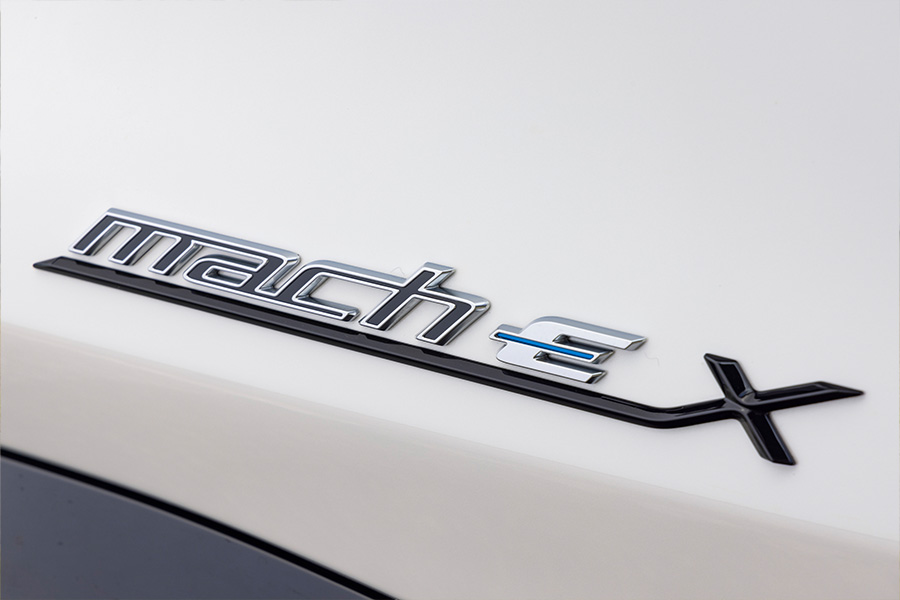
Simply assessing the vehicle on its merits, it comes up short against a really strong group of competitors.
Which places it in a tough spot. The Mach-E is neither a real Mustang, nor a great EV.
Sure, it’s a decent car and it’s commendable that Ford has fired into action with an entrant into the hottest part of the electric market.
We just wish it was a more compelling vehicle at a more competitive price.
2024 Ford Mustang Mach-E Premium at a glance:
Editor’s Rating: 7.5/10
| Price: $86,990 (plus on-road costs) |
Battery: 91kWh lithium-ion |
| Available: Now |
Range: 600km (WLTP) |
| Powertrain: Single rear-mounted permanent magnet synchronous motor |
Energy Consumption: 17.3kWh/100km (WLTP) |
| Output: 216kW/430Nm |
Safety Rating: Five-star (ANCAP 2021) |
| Transmission: Single-speed reduction gear |
Disclaimer: Images supplied by Carsales.
This article was prepared by an independent author. The information contained in this article represents the views and opinions of the original author, and is based on research carried out by the original author. The appearance of the article on Maxxia's website does not constitute an endorsement of its content by Maxxia in any way. The article has been made available for informational purposes only and should not be taken as advice. While all reasonable care has been taken to ensure that the statements made by the original author in the article are fair and accurate, Maxxia does not guarantee or warrant the accuracy or completeness of this information and will not be liable for, or in connection with, any loss or damage suffered as a result of any inaccuracies, errors or omissions or your reliance on this information. You should independently research and verify information before making any decision in respect of a vehicle.

